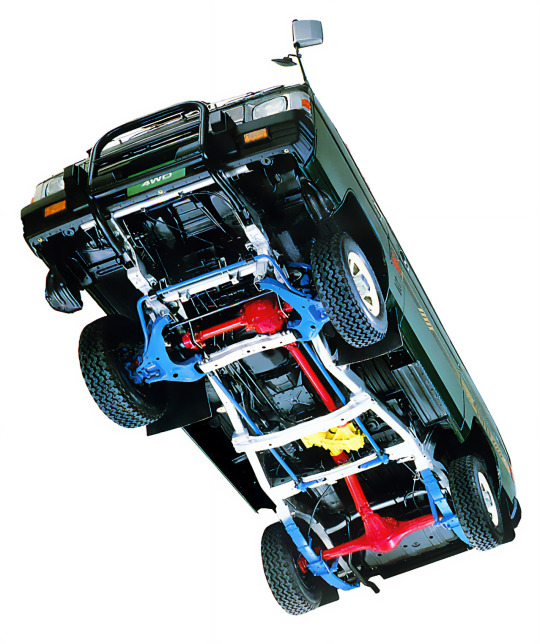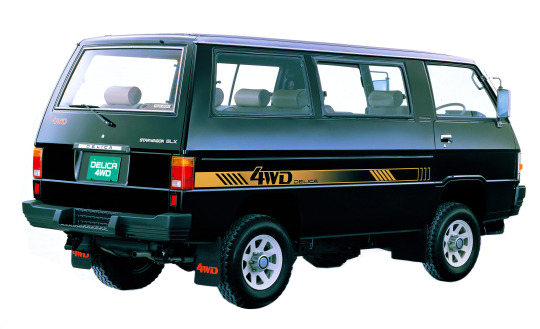#Mitsubishi Delica Star Wagon 4WD
Explore tagged Tumblr posts
Text





Mitsubishi Delica Star Wagon 4WD, 1982. The second generation Delica was made available with 4WD using a modified version of the Pajero's chassis. It was the first Japanese van to be offered with all wheel drive. It was powered by the 1.8-litre Sirius engine which was expanded to 2.0 litres in 1983
#Mitsubishi#Mitsubishi Delica Star Wagon 4WD#Mitsubishi Delica#4WD#Mitsubishi Delica 4WD#1982#forward control#3 row#monobox#MPV#first of its kind#high riding
466 notes
·
View notes
Text
https://3dprintable.shop/product/mitsubishi-delica-star-wagon-4wd-glx-1982-3d-model-stl/
0 notes
Photo

The Mitsubishi Delica name - contraction of “Delivery” and “Car” - dates back to 1968, but it wasn’t until the 1980s that the Delica really came into its own. After the debut of the Mk2 Delica in 1979 it rapidly branched into a much wider lineup of recreation and commercial vans. The formula was perfected with the Mk3 Delica in 1986, although it was not world famous right away. Mitsubishi actually brought this van to the USA in the 1980s as the “Wagon” (bit.ly/3bv2a4X), but it ended up a very minor player thanks to its limited spec. It’s the lifted, 4WD, diesel-powered JDM Delica that’s famous today - in fact, a far more common sight in the USA than the actual U.S.-spec vans. The design language of the Mk3 was called “Soft Cube” by Mitsubishi, although its lines were only “softer” in the sense that the 1979-85 truck looked like it was designed with a T-square. In the 1980s sides were flat and vans were square, and in tax-sensitive Japan designers looked to maximize space within the physical footprint. The outside did not matter as much as what was underneath, and here the truck was designed from the start to integrate the pieces that had been previously applied to the Mk2. In the fall of 1982, Mitsubishi took the frame and 4WD running gear from the then-new Pajero (aka: Montero/Shogun) and attached it to the existing Mk2 Delica “Star Wagon,” bolting in a range of diesels at the same time. When the Mk3 debuted, it was an even more integrated whole with punchier Turbodiesels, Mitsubishi’s 4D56. Being a mid-80s JDM product, the 4WD Delicas were often festooned with tech extras beyond their heavy duty running gear – onboard karaoke systems, and an air-conditioned cold box, and a spectacular glass-paneled ceiling (the “Crystal Lite Roof”), and it came with power retractable sunshades. North America didn’t get this truck until Canadians began importing them in the early 2000s. Perfect for the trails of rural B.C. just as it was for Hokkaido, it earned a quick following with people outside the car community. The Mk3 did eventually get “softer” to look at with a refresh in late 1990, but it was always more about looking out of it than looking at it. https://www.instagram.com/p/CEwrZbfF6mW/?igshid=1s9cedihgaffz
1 note
·
View note
Photo

Mitsubishi Delica Star Wagon Super Exceed 4WD, https://ift.tt/2r89A7N
0 notes
Photo



Mitsubishi Delica Star Wagon 4WD, 1986. The 4x4 passenger-carrying version of Mitsubishi’s forward-control delivery van
#Mitsubishi#Mitsubishi Delica#Mitsubishi Delica Star Wagon 4WD#1986#1980s#4x4#MPV#forward control#all wheel drive#Mitsubishi Star Wagon#3 rows
836 notes
·
View notes
Photo





Mitsubishi Delica Star Wagon 4WD "Chamonix", 1985. A special edition of Mitsubishi’s forward control van equipped for skiers named after a French ski resort (though it was an edition for the Japanese market)
#Mitsubishi#Mitsubishi Delica Star Wagon#Mitsubishi Delica Star Wagon 4WD Chamonix#4x4#4WD#special edition#forward control#1985#1980s#Ski van#monobox#japanese market#Chamonix#MMC
740 notes
·
View notes
Text
https://3dprintable.shop/product/mitsubishi-delica-star-wagon-4wd-1986-3d-model-stl/
0 notes
Text
funky kis járgány, kéne





Mitsubishi Delica Star Wagon 4WD, 1982. The second generation Delica was made available with 4WD using a modified version of the Pajero's chassis. It was the first Japanese van to be offered with all wheel drive. It was powered by the 1.8-litre Sirius engine which was expanded to 2.0 litres in 1983
#Mitsubishi#Mitsubishi Delica Star Wagon 4WD#Mitsubishi Delica#4WD#Mitsubishi Delica 4WD#1982#forward control#3 row#monobox#MPV#first of its kind#high riding
466 notes
·
View notes